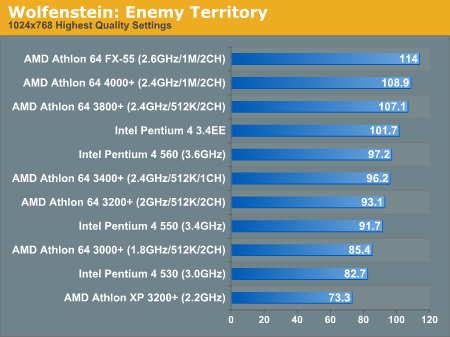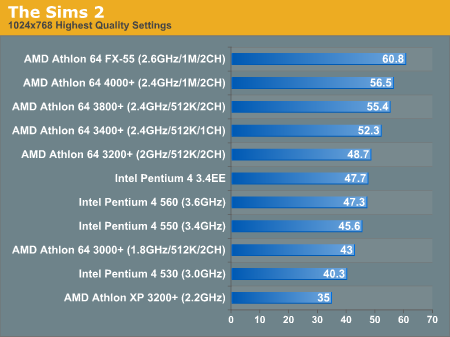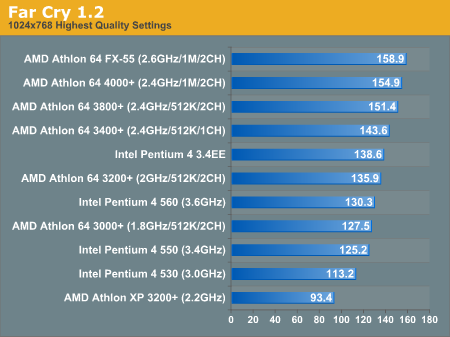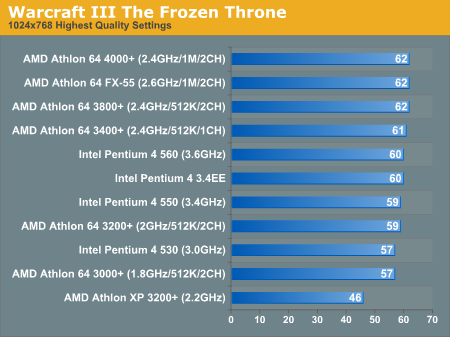AMD Athlon 64 4000+ & FX-55: A Thorough Investigation
by Anand Lal Shimpi on October 19, 2004 1:04 AM EST- Posted in
- CPUs
Wolfenstein: Enemy Territory
An oldie but a goodie, Enemy Territory is still played quite a bit and makes for a great CPU test as today's GPUs can easily handle the rendering load of the Quake 3 based game.
We continue to see dominance from AMD, this time only the top three spots go to AMD chips. The Pentium 4 3.4EE and the Pentium 4 560 both manage to outperform the Athlon 64 3400+ thanks to its single channel memory configuration. ET also shows us a situation where the move to dual channel actually helps the Athlon 64 more than the 7% we've been seeing thus far, here an 11% boost is what we see - although there's barely any performance improvement from the larger cache of the 4000+.
Prescott does reasonably well here, but just not good enough to compete with AMD.

The Sims 2
While a clear departure from our usual game tests, The Sims 2 is more popular than any of the other games we've featured here in certain crowds - it is effectively the Doom 3 of those who prefer life-simulation to first person shooters. And interestingly enough, it makes for a very impressive CPU benchmark.
So who wins the hearts and performance of The Sims? AMD of course, with the top five performers in this test being Athlon 64 processors. Coming in 6th place is the Pentium 4 3.4EE, which is a whopping 21% slower than the Athlon 64 FX-55.
Granted most Sims players will not be shelling out $1,000 for a CPU, but given that the Athlon 64 3200+ can outperform the 3.4EE, they won't have to. Things are back to normal here with a 6% boost from Socket-939 and a minor 2% improvement when the Athlon 64 is given a full megabyte of cache.

Far Cry
Performance under Far Cry echoes what we've already seen, AMD takes the top four spots without much struggle from Intel. While there is some debate about which is the faster content creation chip, there's no debate that the Athlon 64 is the faster gaming chip.

Warcraft III
Although AMD comes out on top here, the performance lead is nothing to cheer about; with the exception of the Athlon XP 3200+, all of the contenders here are GPU bound and all play the game very well (including the Athlon XP).











89 Comments
View All Comments
HardwareD00d - Tuesday, October 19, 2004 - link
Fantastic article, obviously very well thought out.I would have liked to see a comparison between the 4000+ and the "real" FX-53 to really back up your rebadging theory (yeah I know speed+cache+memory width are equal between the two, but just to make sure AMD isn't pulling some magic out of there butt somewhere else).
Marsumane - Tuesday, October 19, 2004 - link
Yes, thanks for the XP comparison. I find it interesting how its not performing as well as it used to in games. (doom 3, farcry, cs:s)Also, your ut2k4 benches seem off. How is doom 3 pulling 50% more frames at the same res? Maybe your ut is at 16x12? I pull similar frames on ut w/ my 9800p oced.
ksherman - Tuesday, October 19, 2004 - link
I like the ending... It sounds mysterious!alexruiz - Tuesday, October 19, 2004 - link
I will suggest again to include some Ulead Video Studio 8.0 benchmarks for video encoding. Ulead is by far the fastest consumer grade video editor / renderer, it is the most complete and one of the most popular. In fact, it is almost 50% faster than Pinnacle 9, and almost 100% faster than videowave.Roxio has really been working with Intel as all previous version of video wave ran better on AMD hardware. As reference, results video wave 6 or 7 would be interesting. Newer doesn't always mean better, as you can see from Adobe Premiere. Version 7.0 is quite slower than 6.5 doing the exact same thing in the same platform.
For DivX encoding, a run with virtualdub/virtualdubmod or DVD2AVI would be nice, as they are very fast and extensively used.
Just some comments
Alex
Araemo - Tuesday, October 19, 2004 - link
Thank you thank you thank you for including an Athlon XP.This allows me to better judge where my current Barton 2.4 Ghz sits. ;P So I know when an upgrade to the next cheap overclocker will give a good enough performance boost to be worth the money.
stephenbrooks - Tuesday, October 19, 2004 - link
Here's an idea to play with: how about some 2D scatter plots of Performance/£ and Performance/Watt? Obviously not on everything - that would clutter it - but perhaps on one or two key things it'd be nice to see.Zar0n - Tuesday, October 19, 2004 - link
EDIT #22 There is no 3400+ for SK 939 only 3500+Zar0n - Tuesday, October 19, 2004 - link
Nice article BUT:You should make C&C power consumption and temperature
Also some OC tests.
The Battle for Value is not correct:
1º WHAT about price of DDR1 VS DDR2?!
2º MB for INTEL are more expensive, ~40€ is a great difference in a MB price.
3º 0.09 AMD are just introduced so they are going to come down, not much but they are.
In order to be fair you should compare with AMD 3400+
AMD as a clear winner here.
mczak - Tuesday, October 19, 2004 - link
power consumption at idle - is this with or without cool 'n' quiet (I suspect without)?Uff - Tuesday, October 19, 2004 - link
I have to agree with #18 - it's not worth paying more than twice the price of a 3400+ just to get 3800+ on 939 platform.Many say 'OH! But s939 is more upgradable!', but if you think about it, by the time you upgrade next there are very likely going to be new motherboards available aswell and you end up upgrading that anyway. Not to mention motherboards cost virtually nothing compared to cpus.